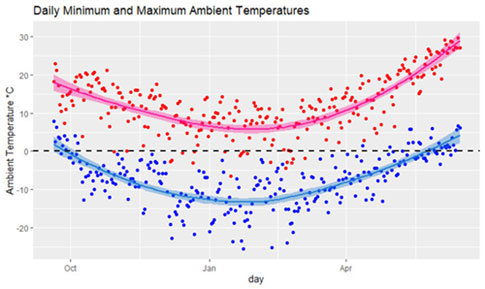|
|
|
|
Theoretical
freeze-thaw nomogram compiled from ambient
temperature data collected
at FLFO stump p47 between 9/20/2017 and
6/5/2018.
|
|
Two
identical on-site weather monitoring systems have
been installed at
FLFO since 2017, each capable of collecting data
related to wind speed
and direction, ambient temperature and relative
humidity, solar
radiation, and liquid precipitation. The premise
for the installation
of these systems is to collect relevant data
needed to characterize the
stumps’ micro-climatic behavior at FLFO and
provide the unique
information necessary to make informed treatment
and conservation
decisions for the petrified stumps. The
environmental data collected is
intended to supplement and not replace local and
regional weather data
necessary for macro-scale analysis of
climate-related phenomena.
The research objectives for the ongoing
environmental monitoring system
are:
- Establish baseline environmental
conditions to which the petrified stumps are
exposed seasonally.
- Identify a hierarchy of vulnerability
related
exposure end environmental conditions.
- Correlate active deterioration with these
environmental factors.
- Evaluate the impact of the shelters on the
environmental performance and deterioration
mechanisms of the petrified
stumps.
|
|
|
|
|
An
embedded
monitoring system was designed and
installed to validate
preliminary hypotheses seeking to
explain the deterioration mechanisms
of the petrified stumps at FLFO.
Characterizing the hygrothermal
performance of the stone is critical.
|
|
Four
type-k thermocouples
were embedded into P47 at varying depths and
orientations to collect temperature data. This
data aims to quantify
the contributing effects of thermal variables such
as solar radiation
gains as well as the thermal response of the stone
to these factors.
Additionally, soil moisture sensors were installed
in the soil atop the
stumps and at grade adjacent to the stump.
Lastly, as part of ongoing CAC research that is
exploring applications
for low-cost, passive embedded moisture
monitoring, a single passive
RFID moisture tag was installed in P47. Given the
nature of this
technology, and leveraging its low-cost, passive,
and sacrificial
nature, the installation of the tag was integrated
with the pilot epoxy
consolidation campaign applied to this stump. The
tag was laminated in
plastic to improve durability, and it was
installed behind a loose
piece of petrified wood on P47. This installation
will evaluate the
methodology in situ as well as the performance of
the applied
treatments without visually intrusive cabling. |
|
|
|
In parallel
to
the embedded monitoring efforts, a time-lapse
photography system was
installed adjacent to P47 to capture
macro-climatic factors, such as
snow deposition patterns and moisture uptake and
wetting, as well as to
detect changes to the fabric of the stump itself.
The system has
exceeded expectation, and the preliminary imagery
collected clearly
demonstrates the catalog of environmental impacts
on exposed
(unsheltered) stumps such as P47. Even under
relatively warmer
conditions, where the ambient diurnal temperature
is well above
freezing, such as in later October, snow can
linger in shaded areas of
the stump depression and within recesses of the
stump itself in excess
of 24 hours (Table 1). This condition has
significant implications for
differential moisture deposition in addition to
the perpetual sources
such as rising damp, falling damp, and lateral
moisture ingress.
|
|

|
Diurnal minimum and
maximum
ambient external temperatures present at
FLFO, compared over a season
between September 2018 and August 2019.
|
|
|
|
|
Preliminary
analysis
of embedded temperature data collected over the
course of 269
days, between 9/20/2017 and 6/5/2018 from P47
reveals a variety of
notable observations relevant to the conditions
and performance of the
petrified stumps. First, and most immediately
apparent, is the thermal
range to which the stump is subjected to at
various depths (Figure 1).
A maximum ambient temperature swing, with a range
of 30.52 deg F (11
deg C) was observed on October 17, 2017. Secondly,
the data collected
was used to calculate the number of theoretical
freeze-thaw days
unsheltered stumps were subjected to. A
Freeze-thaw day is a 24-hour
period during which the conditions for at least
one freeze-thaw event
were present in the ambient environment.
Theoretical freeze-thaw events
are a function of mean daily temperature and mean
diurnal temperature
range (Figure 2) (Wexler, 1982). Unsheltered
stumps were exposed to
theoretical freeze-thaw conditions for
approximately 80% (214 days) of
the observational period. Once enough comparable
data has been
collected for the sheltered stump, P31, a
freeze-thaw comparison should
be calculated to evaluate the actual environmental
performance of the
shelters.
Compared to theoretical conditions, it is possible
to ground-truth
these observations using recorded diurnal ambient
temperature minimums
and maximums rather than calculated means (Figure
3). That is, where
sufficient moisture is present, freeze-thaw
cycling does occur on days
during which the minimum recorded temperature
falls below 0 deg C (32
deg F) and the maximum recorded temperature is
above 0 deg C. At FLFO,
preliminary data suggests 360 individual
freeze-thaw cycles occurred
during the observation period.
|
|







